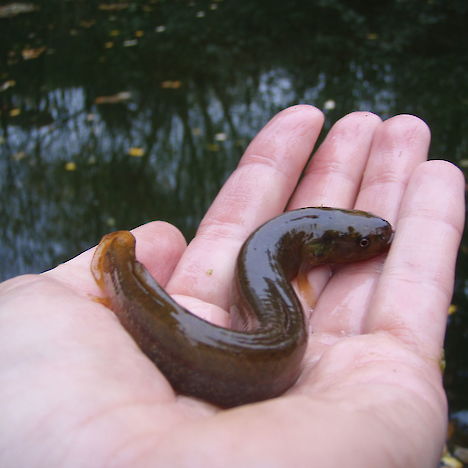Other names:
KowaroThreat category:
Threatened: Nationally Critical?Regions:
CanterburyDistribution:
Canterbury Plains and foothills, mainly between the Ashley and Waitaki rivers.
Description
- Mudfish are small and cigar-shaped, appearing like a small stocky eel.
- The skin is very soft because there are no scales present, and is coloured light brown to grey-brown with profuse speckles and blotches.
- Fins are small and fleshy, with the tail fin being rounded in profile.
Interesting Facts
- Canterbury mudfish are unique to New Zealand.
- Their distribution does not overlap with other mudfish species.
- Mudfish are generally restricted to small, isolated populations and do not carry out lifecycle migrations.
- Occur in wetlands, swampy streams, small waterways and drains that become seasonally dry.
- Feed on invertebrates.
- Spawn during autumn.
- Adults are nocturnal, but the small recently hatched larvae can be seen during the day.
- During dry periods, mudfish can avoid dehydration by remaining inactive in damp areas in the mud and beneath debris and logs.
Association with Plantations
- Mudfish can occur in wetlands or waterways and drains within and adjacent to plantation forestry areas.
- Plantation streams and lakes often have relatively high populations of indigenous fish.
Threats
- Loss of wetlands through drainage schemes, irrigation and land development.
- Destruction of riparian vegetation.
- Competition and predation from introduced fish species.
- Habitat destruction from:
- Modification of riparian margins.
- Introduction of aquatic weeds.
- Siltation.
- Eutrophication (high nutrients).
- Erosion of banks through grazing by livestock, goats and deer.
- Artificial barriers to upstream migration (e.g. culverts, fords with large lips creating a drop off).
- Depleted flows caused by water abstraction.
Management Options and Methods
- Protect all wetland areas.
- Maintain corridors of riparian vegetation along banks. Corridors should be as extensive as possible (refer to Buxton 1991).
- If possible, expand width of riparian zones during later rotation planting.
- Exclude livestock from riparian areas.
- Control deer and goats that could enter riparian areas.
- Comply with best forest operational management practices to avoid damage to riparian areas.
- Provide adequate fish passage through any artificial barriers within streams, e.g. building up downstream side of culverts with Gabion baskets of boulders or using other designs (refer Buxton 1991, Jowett 1999).
- Manage or prevent water abstraction from critical habitat areas.
- Prevent introductions of exotic fish.
- Prevent introductions of aquatic weeds. Educate local users of weed threats and how to prevent spread.
Monitoring Options
- Undertake surveys to identify fisheries values and species.
- Consider repeating fish surveys every few years to ascertain whether key species are still present.
- Liaise with DOC about fish survey and monitoring methods.
- Report findings to DOC.
- Periodic checks of banks to ensure compliance with best forest operational management practices, pest and weed levels, and siltation.
Further Information and Support
- DOC – advice for survey. Website http://www.doc.govt.nz/
- Barrier R. 2003. New Zealand mudfish (Neochanna spp.) recovery plan. Department of Conservation, Wellington.
- McDowall R.M. 2000. The Reed Guide to Freshwater Fishes.
- NIWA website, Atlas of New Zealand freshwater fishes. Contains detailed identification guides and location maps. http://www.niwa.cri.nz/rc/freshwater/fishatlas
- Buxton 1991. New Zealand’s wetlands: a management guide. Wellington, Department of Conservation.
- Jowett I. et al. 1999. Fish passage at culverts: a review with possible solutions for New Zealand indigenous species.


